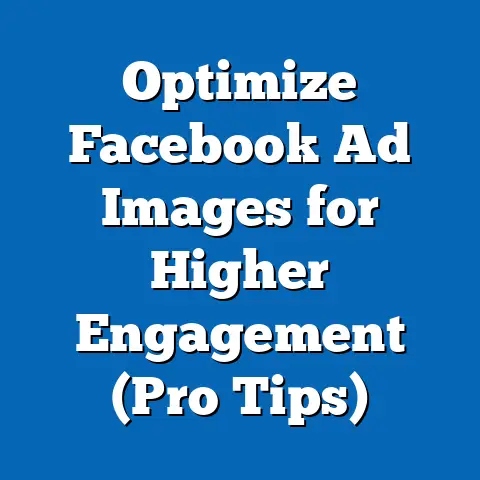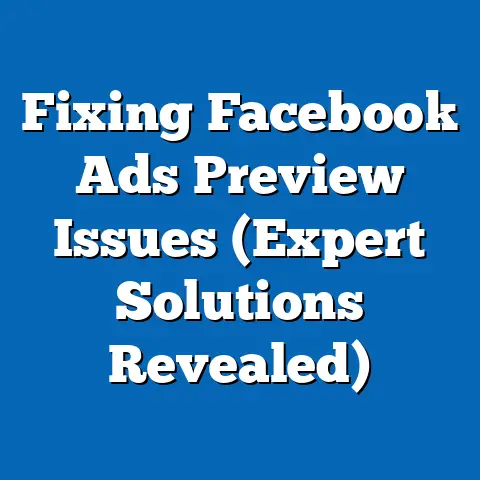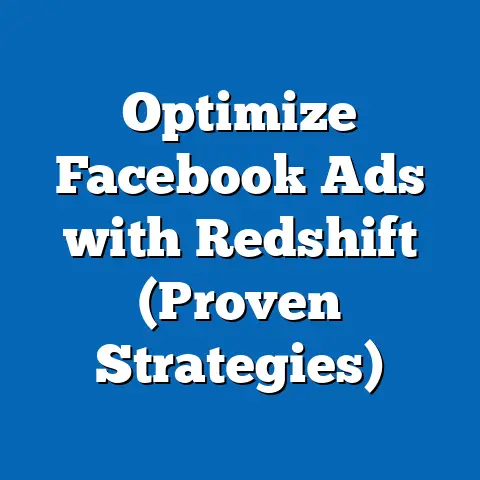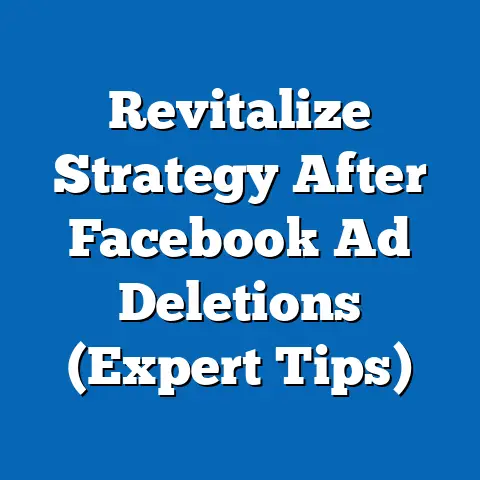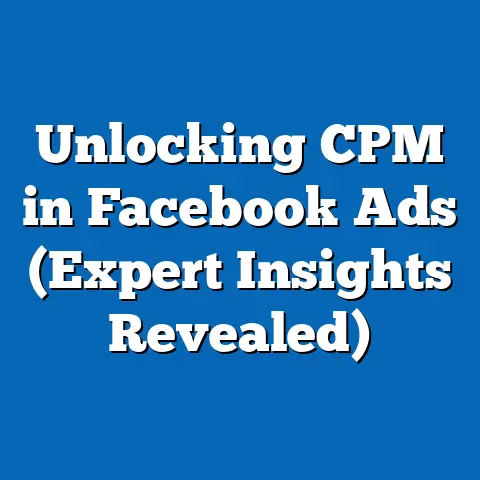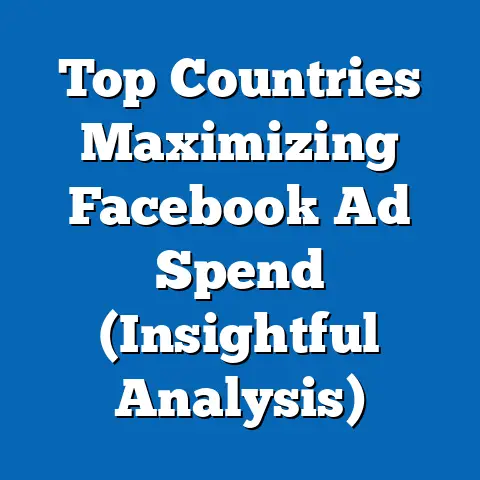Maximize ROI: Best Days to Run Facebook Ads (Expert Guide)
In the world of Facebook ads, where algorithms and audience behaviors shift like the tides, the best days to run ads may be the same days everyone else is running them. Yet, in a sea of sameness, how can brands stand out and maximize their return on investment (ROI)? It’s a question I’ve wrestled with throughout my career, and the answer, as I’ve discovered, lies in understanding not just when people are online, but why and what they’re doing. This guide will delve into the nuances of timing your Facebook ads, moving beyond simple assumptions to provide actionable insights for boosting your ROI.
Understanding the Fundamentals of Facebook Advertising
Facebook advertising has become a cornerstone of digital marketing, and for good reason. With billions of active users, it offers unparalleled reach and granular targeting capabilities. But before we dive into the best days to run your ads, it’s crucial to understand the fundamental principles that govern the platform’s effectiveness.
What is Facebook Advertising?
Facebook advertising is a form of online marketing where businesses pay to display sponsored messages, photos, or videos to Facebook users. These ads appear in various placements, including the news feed, right column, and in-stream videos. The power of Facebook advertising lies in its ability to target specific demographics, interests, behaviors, and even custom audiences derived from your own customer data.
Why is Facebook Advertising Significant?
- Massive Reach: With over 2.9 billion monthly active users, Facebook offers access to a vast potential customer base.
- Granular Targeting: Facebook’s sophisticated targeting options allow you to reach the right people with the right message.
- Measurable Results: Facebook provides detailed analytics and reporting, enabling you to track your ad performance and ROI.
- Versatile Ad Formats: From image ads to video ads to carousel ads, Facebook offers a variety of ad formats to suit your marketing goals.
- Cost-Effectiveness: Compared to traditional advertising channels, Facebook advertising can be a more cost-effective way to reach your target audience.
Key Concepts to Understand
To truly master Facebook advertising, it’s essential to grasp these key concepts:
- Return on Investment (ROI): ROI is the ultimate measure of success for any advertising campaign. It represents the profit generated for every dollar spent on advertising. A high ROI indicates that your ads are effectively driving revenue and justifying your investment.
- Ad Targeting: This involves selecting the specific characteristics of the audience you want to reach with your ads. Facebook offers a wide range of targeting options, including demographics (age, gender, location), interests (hobbies, activities, pages liked), behaviors (purchase history, device usage), and connections (friends of people who like your page).
- Audience Segmentation: This is the process of dividing your target audience into smaller, more homogenous groups based on shared characteristics. By segmenting your audience, you can tailor your ad messaging and creative to resonate with each group, increasing the effectiveness of your campaigns.
- Facebook Ad Auction System: Facebook uses an auction system to determine which ads are displayed to users. Advertisers bid against each other for ad placements, and the winning ads are chosen based on a combination of factors, including bid amount, ad quality, and estimated action rates. Understanding how the auction system works is crucial for optimizing your bids and ad creative.
How Understanding Platform Mechanics Influences Ad Performance
Understanding the mechanics of Facebook advertising, from the algorithm that determines ad delivery to the factors that influence ad relevance, is crucial for optimizing your campaigns. For instance, I’ve found that ads with high engagement rates (likes, comments, shares) tend to perform better in the auction, as Facebook rewards ads that provide a positive user experience.
Takeaway: A solid understanding of Facebook advertising fundamentals is the foundation for creating successful campaigns. By focusing on ROI, mastering ad targeting, segmenting your audience, and understanding the ad auction system, you can significantly improve your ad performance.
The Importance of Timing in Advertising
Timing is everything, especially in the world of advertising. Just as a perfectly timed joke can elicit laughter, a well-timed ad can capture attention and drive conversions. But what makes timing so critical?
The Role of Timing in Advertising Campaigns
Timing plays a crucial role in the success of advertising campaigns for several reasons:
- Relevance: Ads that are delivered at the right time are more likely to be relevant to the user’s current needs and interests. For example, an ad for a coffee shop might be more effective in the morning when people are looking for their caffeine fix.
- Attention: In today’s crowded digital landscape, capturing attention is a major challenge. By timing your ads strategically, you can increase the likelihood that they will be seen and noticed.
- Engagement: Ads that are timed to coincide with peak engagement periods are more likely to generate clicks, likes, comments, and shares.
- Conversions: Ultimately, the goal of most advertising campaigns is to drive conversions, whether it’s sales, leads, or website traffic. By timing your ads to align with the customer journey, you can increase the likelihood of converting prospects into customers.
Studies and Statistics on Timing’s Impact
Numerous studies have demonstrated the impact of timing on ad performance and engagement rates. For example:
- A study by HubSpot found that email open rates are highest on Tuesdays and Wednesdays between 10 AM and 11 AM. While this isn’t directly about Facebook ads, it highlights the importance of understanding when your target audience is most receptive to marketing messages.
- Research by AdEspresso showed that Facebook ad click-through rates (CTR) tend to be higher on weekends, particularly on Sundays. This suggests that people may be more likely to engage with ads when they have more leisure time.
- A report by Nielsen found that TV ad recall is higher during primetime hours, when more people are watching television. This underscores the importance of timing in traditional advertising as well.
Psychological Principles Behind Consumer Behavior
The effectiveness of timing in advertising is rooted in several psychological principles:
- Recency Effect: People are more likely to remember information that they have recently encountered. By timing your ads to coincide with relevant events or triggers, you can increase their memorability and impact.
- Context Effect: The context in which an ad is displayed can influence how it is perceived. For example, an ad for a luxury car might be more effective when shown alongside content about high-end lifestyles.
- Priming Effect: Exposure to one stimulus can influence the response to a subsequent stimulus. By timing your ads to follow relevant content or events, you can prime users to be more receptive to your message.
Takeaway: Timing is a critical factor in the success of advertising campaigns. By understanding consumer behavior patterns, leveraging psychological principles, and analyzing ad performance data, you can optimize your ad scheduling and maximize your ROI.
Analysis of Consumer Behavior Patterns
Understanding consumer behavior is like having a secret weapon in your advertising arsenal. It allows you to anticipate their needs, predict their actions, and deliver the right message at the right time.
Consumer Behavior Trends Throughout the Week
Consumer behavior varies significantly throughout the week, influenced by factors such as work schedules, leisure activities, and social events. Here’s a breakdown of typical consumer behavior trends:
- Monday: People are often focused on work and productivity at the start of the week. They may be less likely to engage with ads, but they may be more receptive to ads related to productivity tools, career development, or stress relief.
- Tuesday & Wednesday: These mid-week days tend to be more balanced, with people settling into their routines. They may be more open to ads related to hobbies, interests, or personal care.
- Thursday: As the weekend approaches, people start to shift their focus towards leisure and entertainment. They may be more receptive to ads related to restaurants, movies, travel, or social events.
- Friday: The “Friday feeling” is real. People are generally in a more positive mood and looking forward to the weekend. They may be more likely to engage with ads related to fun activities, going out, or treating themselves.
- Saturday & Sunday: Weekends are typically characterized by increased leisure time, family activities, and social gatherings. People may be more receptive to ads related to shopping, dining, entertainment, or home improvement.
Peak Engagement Times on Facebook
While consumer behavior trends provide a general overview, it’s important to analyze specific data on when users are most active on Facebook. According to various studies and reports:
- Weekdays vs. Weekends: As mentioned earlier, click-through rates (CTR) tend to be higher on weekends, suggesting that people are more likely to engage with ads when they have more leisure time.
- Morning vs. Afternoon vs. Evening: Engagement rates often peak in the late afternoon and early evening, when people are winding down from work or school. However, this can vary depending on the target audience and industry.
- Specific Times: Some studies have identified specific times when Facebook engagement is particularly high. For example, a report by Sprout Social found that the best times to post on Facebook are Wednesdays at 11 AM and 1–2 PM. While posting and ad engagement are different, it gives us a sense of when people are active.
Impact of Time Zones and Global Audiences
If you’re targeting a global audience, it’s essential to consider the impact of time zones on ad scheduling. What might be prime time in one country could be the middle of the night in another. To address this, you can use Facebook’s ad scheduling features to target specific time zones and ensure that your ads are delivered when your target audience is most active. I often find that creating separate ad sets for different time zones yields better results than a one-size-fits-all approach.
Takeaway: Understanding consumer behavior patterns and peak engagement times on Facebook is crucial for optimizing your ad scheduling. By targeting specific days and times when your target audience is most active, you can increase the relevance, attention, and engagement of your ads, ultimately driving more conversions.
Best Days to Run Facebook Ads
Now that we’ve laid the groundwork, let’s dive into the specifics of the best days to run your Facebook ads. While there’s no one-size-fits-all answer, I’ll provide a detailed analysis of each day of the week, along with examples and case studies to illustrate key points.
Monday: The Start of the Week
- Potential: Monday can be a challenging day to run ads, as people are often focused on work and productivity. However, it also presents an opportunity to capture their attention with ads that address their needs at the start of the week.
- Mindset: Consumers on Monday are typically in a goal-oriented mindset, focused on planning and tackling their to-do lists. They may be receptive to ads that offer solutions to their problems or help them be more productive.
- Ad Ideas: Consider running ads for productivity tools, time management apps, online courses, or career development resources. You could also target ads to people who are feeling stressed or overwhelmed, offering them relaxation techniques or stress-relief products.
- Example: A company selling project management software might run ads on Monday targeting small business owners and freelancers, highlighting the benefits of their software for improving productivity and organization.
Tuesday & Wednesday: Mid-Week Opportunities
- Potential: Tuesday and Wednesday tend to be more balanced days, with people settling into their routines. This presents an opportunity to engage them with ads related to their hobbies, interests, or personal care.
- Mindset: Consumers on Tuesday and Wednesday are typically in a more relaxed and receptive mindset. They may be more open to exploring new products or services that align with their interests.
- Ad Ideas: Consider running ads for hobby-related products, fitness programs, healthy recipes, or personal care items. You could also target ads to people who are feeling bored or uninspired, offering them creative activities or entertainment options.
- Example: A yoga studio might run ads on Tuesday and Wednesday targeting people interested in fitness and wellness, offering them a free introductory class or a discount on a monthly membership.
Thursday: Transitioning into the Weekend
- Potential: As the weekend approaches, people start to shift their focus towards leisure and entertainment. This presents an opportunity to capture their attention with ads related to restaurants, movies, travel, or social events.
- Mindset: Consumers on Thursday are typically in a more anticipatory and excited mindset, looking forward to the weekend. They may be more receptive to ads that offer them ideas for fun activities or help them plan their weekend.
- Ad Ideas: Consider running ads for local restaurants, movie theaters, concert venues, or travel destinations. You could also target ads to people who are looking for social events or activities, offering them tickets or discounts.
- Example: A local brewery might run ads on Thursday targeting people interested in craft beer and live music, inviting them to a weekend event featuring local bands and food trucks.
Friday: The “Friday Feeling”
- Potential: The “Friday feeling” is real. People are generally in a more positive mood and looking forward to the weekend. This presents an opportunity to engage them with ads related to fun activities, going out, or treating themselves.
- Mindset: Consumers on Friday are typically in a celebratory and indulgent mindset, ready to unwind and enjoy themselves. They may be more likely to make impulse purchases or treat themselves to something special.
- Ad Ideas: Consider running ads for restaurants, bars, nightclubs, spas, or retail stores. You could also target ads to people who are looking for ways to relax and de-stress, offering them massages, facials, or other pampering treatments.
- Example: A local spa might run ads on Friday targeting people interested in relaxation and self-care, offering them a discount on a massage or facial.
Saturday & Sunday: Weekend Behaviors
- Potential: Weekends are typically characterized by increased leisure time, family activities, and social gatherings. This presents an opportunity to engage people with ads related to shopping, dining, entertainment, or home improvement.
- Mindset: Consumers on weekends are typically in a more relaxed and leisurely mindset, with more time to browse and explore. They may be more receptive to ads that offer them inspiration, ideas, or solutions for their weekend activities.
- Ad Ideas: Consider running ads for retail stores, restaurants, amusement parks, museums, or home improvement stores. You could also target ads to people who are planning family activities or social gatherings, offering them ideas for games, recipes, or party supplies.
- Example: A home improvement store might run ads on Saturday and Sunday targeting homeowners interested in DIY projects, offering them a discount on paint, tools, or gardening supplies.
Case Studies of Brands Succeeding on Specific Days
- Domino’s Pizza: Domino’s often sees a surge in orders on Friday and Saturday nights. Their Facebook ads during these times focus on highlighting special deals and easy online ordering, catering to the weekend crowd looking for a convenient meal.
- Etsy: Etsy often promotes handcrafted gifts and unique items on weekends, targeting users who have more time to browse and shop for special occasions or personal treats.
- Netflix: Netflix’s ads often ramp up on weekday evenings, targeting people who are looking for entertainment options after a long day at work.
Takeaway: The best days to run Facebook ads depend on your target audience, industry, and marketing goals. By understanding the mindset and behavior of consumers on different days of the week, you can tailor your ad scheduling and messaging to maximize your ROI.
Seasonal and Holiday Considerations
Beyond the weekly trends, seasonal events and holidays can significantly impact ad performance. These occasions often trigger specific consumer behaviors and sentiments, creating unique opportunities for advertisers.
How Holidays and Seasonal Events Impact Ad Performance
- Increased Spending: Holidays like Black Friday, Christmas, and Valentine’s Day are associated with increased consumer spending. People are more likely to make purchases during these times, making them ideal for running promotional ads.
- Emotional Connection: Holidays and seasonal events often evoke strong emotions, such as joy, gratitude, or nostalgia. Ads that tap into these emotions can resonate more deeply with consumers and drive higher engagement.
- Themed Content: Holidays and seasonal events provide a natural opportunity to create themed content that aligns with the occasion. This can include festive visuals, holiday-specific messaging, or special promotions.
- Competitive Landscape: The competitive landscape can change significantly during holidays and seasonal events. Many advertisers increase their ad spend during these times, which can drive up ad costs. It’s important to plan ahead and optimize your bids to remain competitive.
Capitalizing on Major Holidays
Here are some tips for capitalizing on major holidays:
- Black Friday/Cyber Monday: Start planning your Black Friday/Cyber Monday campaigns well in advance. Offer exclusive deals and discounts, and create a sense of urgency to encourage immediate purchases.
- Christmas: Christmas is a time for giving and celebration. Focus on ads that promote gift ideas, holiday decorations, or festive experiences.
- Valentine’s Day: Valentine’s Day is all about love and romance. Target ads to couples, singles, or people looking for gift ideas for their loved ones.
- Mother’s Day/Father’s Day: These holidays are a time to honor parents. Focus on ads that promote gifts or experiences that celebrate mothers and fathers.
- Local Events: Don’t forget to capitalize on local events, such as festivals, concerts, or sporting events. Target ads to people who are attending or interested in these events, offering them special deals or promotions.
Aligning Campaigns with Consumer Sentiment
It’s crucial to align your campaigns with consumer sentiment during holidays and seasonal events. For example, during the COVID-19 pandemic, many advertisers shifted their messaging to focus on empathy, support, and community. By understanding the emotional climate, you can create ads that resonate with your target audience and build trust.
Takeaway: Holidays and seasonal events offer unique opportunities to boost your ad performance. By understanding the consumer behaviors and sentiments associated with these occasions, you can create themed content, offer special promotions, and align your messaging to maximize your ROI.
Testing and Optimization Strategies
While the insights I’ve shared so far can provide a solid foundation for your Facebook ad scheduling, it’s important to remember that every audience is unique. The best way to determine the optimal days and times to run your ads is through testing and optimization.
The Concept of A/B Testing
A/B testing, also known as split testing, involves creating two or more versions of an ad and showing them to different segments of your audience. By comparing the performance of each version, you can identify which elements resonate most effectively with your target audience.
In the context of ad scheduling, you can use A/B testing to determine the best days and times to run your ads. For example, you could create two identical ads and schedule one to run on weekdays and the other to run on weekends. By tracking the performance of each ad, you can determine which days generate the highest ROI.
Analyzing Ad Performance Data
Analyzing ad performance data is crucial for refining your ad scheduling strategies. Facebook provides a wealth of data on your ad performance, including:
- Click-Through Rate (CTR): This measures the percentage of people who click on your ad after seeing it. A high CTR indicates that your ad is relevant and engaging.
- Cost Per Click (CPC): This measures the average cost you pay for each click on your ad. A low CPC indicates that your ad is cost-effective.
- Conversion Rate: This measures the percentage of people who take a desired action (e.g., make a purchase, fill out a form) after clicking on your ad. A high conversion rate indicates that your ad is effectively driving conversions.
- Return on Ad Spend (ROAS): This measures the revenue generated for every dollar spent on advertising. A high ROAS indicates that your ad is generating a positive return on investment.
By tracking these metrics over time, you can identify trends and patterns that inform your ad scheduling decisions. For example, you might notice that your CTR is consistently higher on weekends, or that your conversion rate peaks in the late afternoon.
Tools and Methods for Optimizing Ad Scheduling
Facebook offers several tools and methods for optimizing your ad scheduling:
- Ad Scheduling: This feature allows you to schedule your ads to run on specific days and times. You can use this feature to target peak engagement periods or align your ads with specific events or promotions.
- Automated Rules: This feature allows you to set up rules that automatically adjust your ad bids, budgets, or schedules based on performance data. For example, you could set up a rule that automatically increases your bids on weekends if your CTR is higher than average.
- Facebook Pixel: This code snippet allows you to track the actions that people take on your website after clicking on your ad. By tracking conversions, you can optimize your ad scheduling to target the days and times that generate the most sales or leads.
Takeaway: Testing and optimization are essential for maximizing your ROI on Facebook ads. By using A/B testing, analyzing ad performance data, and leveraging Facebook’s ad scheduling tools, you can refine your strategies and target the best days and times to reach your target audience.
Case Studies of Successful Campaigns
Let’s take a look at some real-world examples of brands that have effectively maximized their ROI by strategically choosing the best days to run their Facebook ads.
Case Study 1: A Local Restaurant
- Challenge: A local restaurant was struggling to attract customers during the week.
- Solution: The restaurant decided to run Facebook ads targeting people within a 5-mile radius, offering a special “Happy Hour” discount on appetizers and drinks on Thursdays and Fridays from 5 PM to 7 PM.
- Results: The restaurant saw a significant increase in foot traffic during Happy Hour on Thursdays and Fridays, resulting in a 20% increase in overall revenue.
- Key Takeaway: By targeting ads to specific days and times when people are looking for dining options, the restaurant was able to attract new customers and boost their revenue.
Case Study 2: An E-Commerce Store
- Challenge: An e-commerce store selling handcrafted jewelry was struggling to generate sales during the week.
- Solution: The store decided to run Facebook ads targeting people interested in fashion and accessories, offering a free shipping promotion on weekends.
- Results: The store saw a significant increase in sales on weekends, resulting in a 30% increase in overall revenue.
- Key Takeaway: By targeting ads to specific days when people have more time to browse and shop, the e-commerce store was able to boost their sales and revenue.
Case Study 3: A Fitness Studio
- Challenge: A fitness studio was struggling to attract new members.
- Solution: The studio decided to run Facebook ads targeting people interested in fitness and wellness, offering a free introductory class on Saturday mornings.
- Results: The studio saw a steady stream of new members signing up for the free introductory class on Saturdays, resulting in a 15% increase in overall membership.
- Key Takeaway: By targeting ads to a specific day when people are looking for fitness activities, the fitness studio was able to attract new members and grow their business.
Takeaway: These case studies demonstrate the power of strategic ad scheduling. By understanding the needs and behaviors of your target audience, you can tailor your ad scheduling and messaging to maximize your ROI.
Future Trends in Facebook Advertising
The world of Facebook advertising is constantly evolving, driven by emerging technologies and changing consumer behaviors. Let’s take a look at some future trends that could influence the best days to run your ads.
The Influence of AI and Machine Learning
Artificial intelligence (AI) and machine learning (ML) are already playing a significant role in Facebook advertising, and their influence is only expected to grow in the future. AI and ML algorithms can analyze vast amounts of data to identify patterns and predict user behavior, enabling advertisers to optimize their ad scheduling with unprecedented precision.
For example, AI-powered tools can analyze your ad performance data to identify the best days and times to reach your target audience, and automatically adjust your ad scheduling accordingly. These tools can also personalize ad messaging and creative in real-time, based on individual user preferences and behaviors.
Potential Shifts in Consumer Behavior
Consumer behavior is also constantly evolving, influenced by factors such as technological advancements, social trends, and economic conditions. Advertisers need to stay abreast of these shifts and adapt their strategies accordingly.
For example, the rise of mobile devices has led to a shift in consumer behavior, with people spending more time on their smartphones and tablets. This means that advertisers need to optimize their ads for mobile devices and target ads to specific times when people are most active on their mobile devices.
The Metaverse and Immersive Advertising
The metaverse, a virtual world where users can interact with each other and digital objects, is poised to revolutionize the advertising landscape. In the metaverse, advertisers can create immersive and interactive experiences that engage users in new and exciting ways.
For example, a clothing brand could create a virtual store in the metaverse where users can try on clothes and make purchases. A travel company could create a virtual tour of a destination, allowing users to experience it before booking a trip.
Takeaway: The future of Facebook advertising is likely to be shaped by AI, machine learning, changing consumer behaviors, and emerging technologies like the metaverse. Advertisers who embrace these trends and adapt their strategies accordingly will be best positioned to maximize their ROI.
Conclusion
We began with a paradox: in a world of algorithmic complexity and shifting audience behaviors, how can advertisers cut through the noise and pinpoint the best days to run Facebook ads? While conventional wisdom might suggest that popular days are the key, the real opportunity lies in a deeper understanding of your audience.
As I’ve outlined throughout this guide, there’s no magic bullet or one-size-fits-all solution. The “best” days are inextricably linked to your specific target audience, your industry, your marketing goals, and even the specific product or service you’re promoting.
The key takeaways are:
- Know Your Audience: Understand their daily routines, weekend habits, and seasonal behaviors.
- Test and Optimize: Use A/B testing to experiment with different days and times, and analyze your ad performance data to identify trends.
- Stay Flexible: The advertising landscape is constantly evolving, so be prepared to adapt your strategies as needed.
- Embrace Technology: Leverage AI and machine learning tools to automate and optimize your ad scheduling.
Ultimately, the goal is to create ads that are relevant, engaging, and timely. By understanding your audience, testing your strategies, and adapting to change, you can maximize your ROI and achieve your marketing goals.
So, I encourage you to take these insights and consider how you can apply them to your own Facebook advertising strategies. Experiment, analyze, and iterate. The best days to run your Facebook ads are waiting to be discovered.

